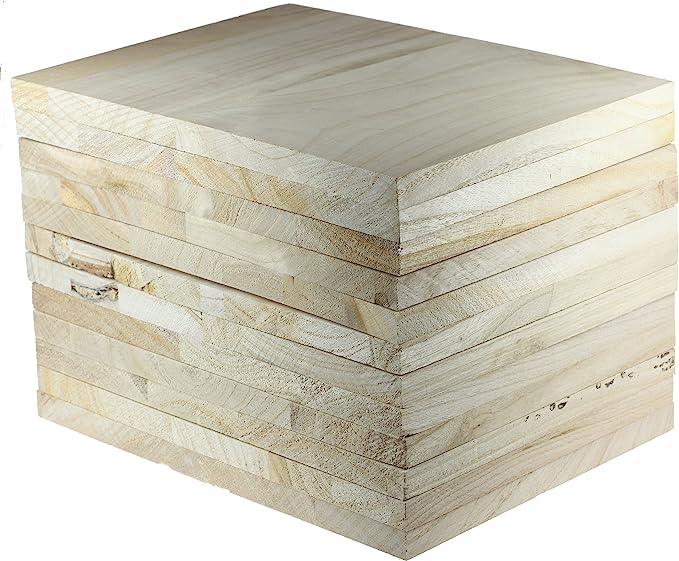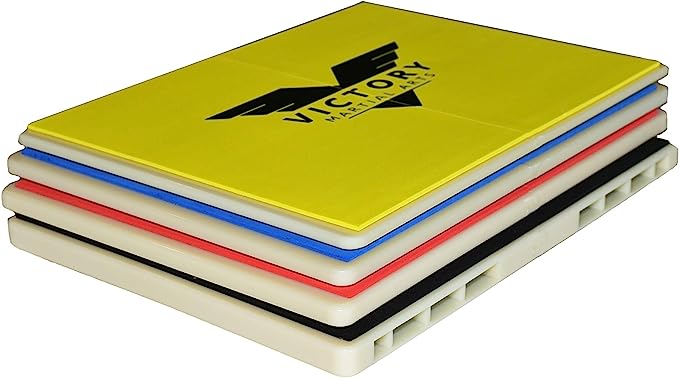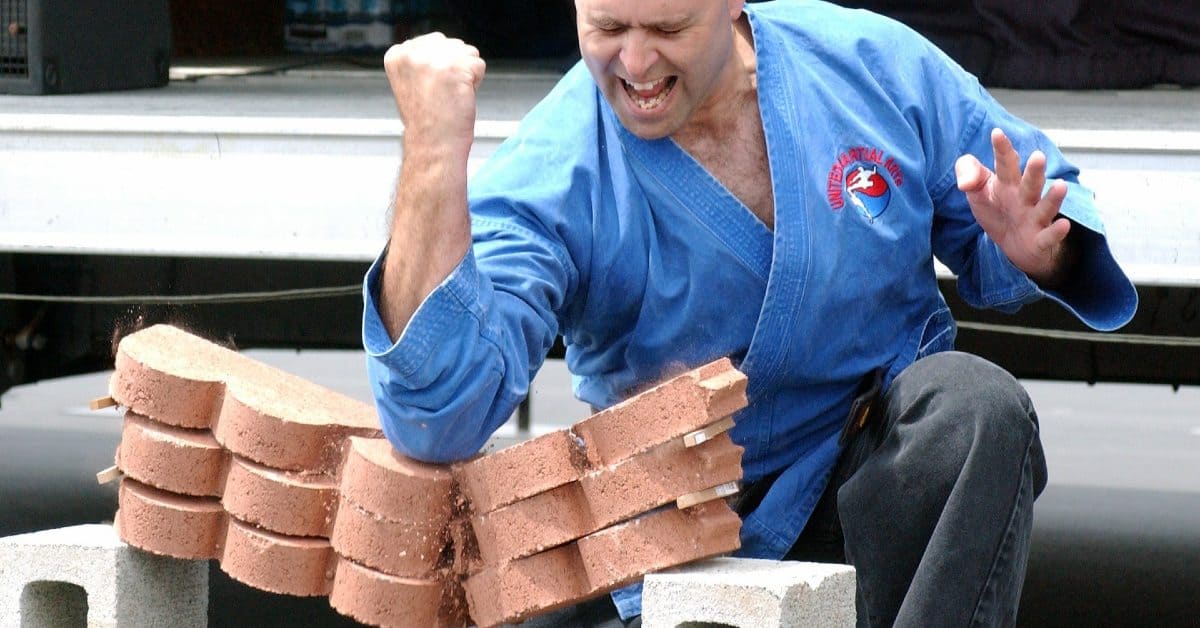When mentioning karate to anyone, they might think of a Jackie Chan movie or perhaps Bruce Lee in his iconic yellow outfit, maybe even with nun-chucks in his hands. There is, however, a staple of karate (and a couple of other martial arts) which is also known by everybody. Those are the legendary karate boards and karate board smashing.
With great karate power comes great board smashing ability, and today we are here to give you an article about everything that has to do with the practice. Aside from how flashy board-breaking looks, there is quite a lot of tradition to it and it also has much practice behind it. Read on if you are interested in the details of karate boards and their destruction!
Why Do They Break Boards in Karate?
For anyone a bit less prone to getting sucked in by the magic of Eastern martial arts like karate, many of the activities and techniques they perform might seem weird, maybe even outright ridiculous. If you are such a person, or you are just interested in the actual reason behind breaking boards, you have come to the right place.
For the untrained but intrigued eye, breaking boards of wood and possibly even blocks of concrete probably looks like a simple display of power, designed to awe the crowds and draw in more and more admirers of the style and its masters. Somewhat like a weird flex mixed with a marketing strategy that targets emotions.
Anyone with a basic understanding of Eastern martial arts knows they are rather philosophical, so the egoistical-looking display of board-breaking might seem to be in conflict with the martial arts’ philosophical nature, which it is. Breaking boards in karate and other martial arts is quite strictly not a display of power, even though it is somewhat of a test of it, though in a non-direct way.
There can be parallels drawn between karate board-breaking and the cutting of rolled-up tatami mats with katanas, a practice well-known in Japanese Samurai culture. Neither are displays of power, much rather displays of technique, of respect to the heritage, and physical practice.
The reason it is a good practice and display of technique is that it isn’t easy to break boards. Clearly, we aren’t talking about the boards visible in scam-artists’ videos which are sawed in half before the action begins, but the actual ones. We will talk later about what they are exactly made of, but one thing is for sure: they aren’t easy to break.
They are made to be rather small usually, which makes it crucial for the karate practitioner to hit the very center of the plank, with a strong, precise, and well-aligned strike. The alignment of the fists is also essential, since hitting it with the pinkie joints can result in bone fracture. Also, when you hear any karate master talking about how to punch, they will always tell you that you shouldn’t aim for your target, you should aim behind your target.
This way you will have larger momentum and more force. Knowing beforehand that the plank might break your hand but still following through with a confident and precise punch is an ultimate sign of grit and determination.
There is also a physical element to it, however, which is basically the strengthening of your hand. Almost any type of growth in the human body starts with a fracture, rip, or breakage; some sort of damage. Basically, when you lift weights, you create micro-tears in your muscle fiber, which your body will heal and actually make stronger (given that there is sufficient nutrition for it to do so) so your body can withstand the challenge that you previously put it through.
The same thing happens with your bones. If you or a childhood friend of yours has broken a bone while you were young, you have definitely heard a doctor or parent consoling a child by telling them not to worry, since their bones will become stronger than they were.
Hitting karate boards strengthens the bones in your fist by causing miniature bone fracture, which will force your body to create stronger and stronger layers of bone, thus making your fist a lot sturdier than usual. This is one of the origins of where board-breaking came from; according to verbal anecdotes and a few written records, karate practitioners were hitting tree trunks with their hands to strengthen them, just like the Muay Thai people did with their shins.
What Kind of Boards are Used in Karate?
Again, we won’t describe the type of boards used in scam karate videos, since those are clearly the cheapest type of wood, prepared to be blown apart by the wind. However, there are a couple of traditional types and sizes of wood that karate masters and students use to train wood breaking.
There are many materials that are used for the production of karate boards, like wood, plastic, concrete, glass, metal, or bricks. However, the most common ones are the wood and plastic boards, since they are the cheapest to make and can be used by the widest portion of karate practitioners. Aside from this, things like metal, glass, and concrete can easily injure a karateka, which is not the goal of the practice, even less of a wide-audience demonstration.
Plastic boards are usually made to be re-breakable. That means that they are made from two separate, interlocking parts that can be fitted back together once broken. This makes them really practical since a wooden plank can’t be reassembled after breakage. In any traditional karate setting, however, may that be a demonstration, ceremony, or just practice, the usage of plastic breaking boards would not be a normal sight. Some traditional karate masters might even think of it as a disrespectful gesture towards the tradition.
The true and traditional karate boards are made of wood. There are a couple of different types of wood used around the world, but the industry-standard, as well as the traditional one, is pine wood.
Pine is the perfect wood for breaking since it is crisp and sturdy, but soft enough to not cause injury and to allow even a beginner to break a thinner board. Woods like oak and birch are categorized as hardwood, which is no surprise seeing as a 1-inch oak board would most probably break anyone’s hand. Pine is softwood, which makes it faster in terms of growth speed and also better for use in karate for breaking.
The second most popular (arguably, since there is not much data on karate wood popularity; pine is the unanimous winner) wood used for karate board-breaking is paulownia food. It is a soft and supple alternative to the pine boards if you live in regions where it might be more readily available than pine.
The size of the boards varies by the skill level of the board-breaker. The size most commonly used for children ages 4-5 is 4″×12″×½″, while older children and adults use boards with sizes ranging from 6″×12″×1″ to 12″×12″×1″. The way testing is also made harder is by increasing the thickness of the board.
Some really extreme versions can go all the way up to 3 inches, though the use of that is very rare, especially with wooden boards, mostly for safety reasons. Should a grown man try to punch through a 3-inch thick piece of wood, they will most likely regret it, unless they spent a lot of time (years) conditioning their hands.
Are Karate Boards Easy to Break?
When watching a video of karate masters breaking boards, sometimes many of them simultaneously, one might wonder how hard it really is to perform this feat of strength and technique, since the masters really make it look very easy.
The fact is, it really isn’t that hard to break boards, on the basic level. There are some karate schools in which children are asked to try to punch through a wooden plank on their 3rd training, as proof that the instructors provide quality teaching to the children. It isn’t very physically demanding to punch through a 1-inch wooden plank, especially with the iconic knife-hand punch (a vertical punch from above one’s head onto a plank, with an open palm), however, there are many ways to make it more difficult.
Choosing a thicker wooden board as the victim of a karate practitioner’s strike isn’t the only way to increase the difficulty of the task. Increasing the difficulty of the technique that is to be performed is a major way to make the plank-breaking a lot more difficult. If instead of a knife-hand strike, one shall perform a straight punch, it already makes alignment and precision a lot more difficult, since the range of motion is much more difficult to keep steady in a straight direction away from the body than in just a straight line downwards.
From here on, you can already imagine the countless techniques which become harder and harder to perform with the strength needed to break a wooden plank. One of the most absolutely mindblowing techniques performed while breaking wood is actually part of taekwondo and consists of several types of extremely high spinning jump-kicks. These, however, aren’t what karate deals with.
How Do Karate Guys Break Boards?
Okay, so we have covered the basics and the reasons behind board-breaking, and also the materials the boards are made from, what is left is only the technique itself. Even though the fundamentals are easy to learn, there are some elemental rules one has to follow in order to be successful at breaking boards without injuring themselves.
The first and maybe most important part has to do with the positioning of the plank itself. You should always place the board so you will be able to strike it with the grain. For those who might not know what that means, we will elaborate.
Basically, trees are made of layers (the ones which you see if you see a cut tree’s trunk). These are clusters of tree fiber that create a cohesive entity, and there is a line between these clusters of fibers which has less connective fiber and is thus much easier to separate than the cohesive clusters of tissues.
Striking with the grain means that your hand or foot should be aligned in the direction of the grains. If the grains of the wood run front-to-back, you will easily punch through it, however, if you take a soft pine wood and place it in front of you with the grains running sideways, you will need at least 2 to 3 times the power to punch through it.
Another major part of breaking the boards still has to do with preparation, and that is to bake the planks for a while on a low setting if they aren’t dry enough. Working with wet or even a little bit moist wood can give you a really hard time and can also make the wooden plank itself a lot heavier.
Karate board manufacturers usually make sure that the quality of the wood you buy from them is consistent, which also covers this aspect. They make sure that every plank is as brittle and dry as any other, in order to require a consistent punching power and technique which will make it easier to train consistently and set goals properly.
The techniques themselves can’t really be taught through a text, but a level of familiarity can be gained by reading somewhat about them, so we naturally will describe one of the most basic techniques, and what it is consisted of.
The classic straight punch, commonly known as Choku-Tsuki in karate terminology, is performed from a static, moderately low stance, with the knees bent to provide stability and a firm basis to gain momentum from when stepping forward.
Then, while stepping forward with the back leg (sometimes the technique is performed without stepping forward), the punch is delivered from the hip while rotating the fist to generate maximum force. Usually, a shout, also known as Kiai is sounded by the performer, which by contracting all abdominal muscles has been shown to amplify the attacker’s strength. The proper form makes the karateka easily able to punch through multiple layers of pine wood boards at once. Click on this link to see a karateka perform this move on Youtube, in slow-motion!
Best Karate Breaking Board – Overall
Tiger Claw Wood Breaking Board
These boards are crafted from lightweight laminated real wood called Paulownia, offering a safe and easy way to practice breaking techniques. Board breaking is not only a powerful demonstration of skill, but also a means to develop confidence, precision, and power in martial arts. The Tiger Claw Wood Breaking Boards are constructed to ensure safety during breaking practice. They are specifically engineered to break easily, allowing you to focus on technique rather than struggling with overly resistant boards. Check them out if you are planning on organizing an event in your dojo for multiple people, or if you just want to practice and hone your own skills.

Pros
- Lightweight and easy to handle
- Sturdy
- Challenging enough for martial arts trainers
Cons
- A bit expensive compared to other options
There is quite a chance that you got motivated to break some planks after reading this article and watching the video. If you feel like you want to unleash your inner Bruce Lee, we have just the right products available on Amazon which will be perfect for you to practice on.
The best one overall, in terms of size, price and quality is the Tiger Claw Wood Breaking Board, made out of the second most popular board material, paulownia, and are perfect for beginners and advanced karate practitioners alike, since stacking them up will provide a decent challenge for the best martial artist.
You can choose different sizes and amount you would like to order, but we recommend a 12-pack of 18 mm (0.7 inches) boards for the best experience. This combination will cost you around 50 dollars, at the time of writing this article, that is the price they are listed at. Make sure to check the product out if you are interested!
Best Karate Breaking Board – Budget Pick
Rebreakable Board by Victory Martial Arts
These rebreakable karate boards are designed to enhance your martial arts skills while providing convenience. Crafted with high impact molded plastic, they are built to withstand powerful strikes. The rubber padding on both sides ensures a secure grip for the holder, allowing for precise and controlled breaks. The Rebreakable Board offers easy reusability, allowing you to break it, slide it back together, and break it again. Featuring the Victory Martial Arts logo, these boards make it easy to aim for the center and improve your accuracy.

Pros
- Realistic practice experience for breaking real wood boards, helping to prepare for martial arts tests and tournaments
- Sturdy and comparable to other well-known brands in terms of quality and performance
- Allowes for home practice and saves money compared to using real boards
- Suitable for kids
Cons
- May weaken or crack after a short period of use
- Foam padding is thin
If you aren’t into professional breaking or train a class, you might not think buying 12 wooden planks for 50 bucks is worth it, since that only means 12 well-placed punches (or less, if you stack them up), which isn’t worth that much money.
In this case, we have found the best budget pick for you in the karate breaking board category. It is sold under the name Rebreakable Boards Martial Arts at Amazon and is the best value-for-money option out there. It is made of plastic, which means you buy one of these products for around 30 bucks and they re-use them many times until the locking mechanism doesn’t break or it becomes unusable for some other reason.
They come in different colors and the different colors represent different thicknesses as well, so you can order a really thin yellow board or perhaps a thick black one if you are up for the challenge. If you want to buy a breaking board you can use it many times and which won’t break the bank, definitely check out this product.

